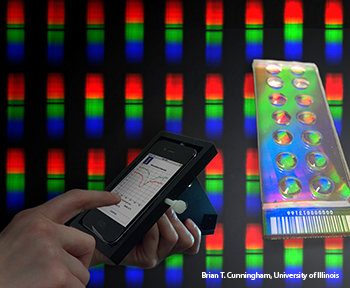
A smartphone cradle and app make a handheld biosensor that uses the phone’s own camera and processing power to detect molecules or cells.
As smartphones catch up to dedicated digital cameras in their imaging capabilities, researchers are devising ways to use the popular devices to supplement or replace expensive, dedicated lab equipment. Scientists at the University of Illinois at Urbana-Champaign (U.S.A.) have devised a custom cradle to convert a smartphone into a photonic crystal biosensor (Lab on a Chip 13, 2124).
Electrical engineering professor Brian T. Cunningham and his colleagues created a photonic crystal from a polymer grating coated with silicon dioxide and titanium dioxide. The photonic crystal, with a center wavelength of 565 nm, sits on a standard glass microscope slide for ease of handling. The team designed the system surrounding the photonic crystal to measure shifts in the peak wavelength value of the minimum transmission efficiency of light from a biological sample.
To align the smartphone with the rest of the optical system, the researchers designed a handheld cradle for the device and other optical components, such as a collimating lens and polarizer. The touchscreen interface remains uncovered so that the end user can control the system through the customized app.
The spectrum of light passed through the photonic crystal covers a region about 750 × 100 pixels on the smartphone’s sensor. The user must focus the smartphone at infinity in order to get the best spectral resolution. The app captures the incoming spectrum of light and analyzes it to find the shift in the spectral “line” or resonant reflection between a bare photonic crystal and a biological sample. The Illinois team used a sample of porcine immunoglobulin G to test the detection limits of the system.
The biosensing smartphone system avoids the need for fluorescent labeling or tagging of the substances of interest. The prototype system could herald the development of home-based “personalized medicine” applications or of diagnostic tools to be used in resource-poor regions of the world.
